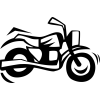We visited the Real Academía - another gallery, which used to be under the direction of the famous Spanish painter, Francisco de Goya. A lot of his work was featured here, and when we completed viewing the artwork on an entire level of the exhibition space, we went to another area called Calcomographía, which is an early form of lithography. To our disappointment, this section was closed for the day.
A man greeted us at the entrance to this section of the gallery, holding a pair of cotton gloves, which immediately caught my attention. I deduced that he was involved with some kind of art preservation, or perhaps was an expert in carbon dating or something similar.
What ensued was extremely interesting. Firstly, he explained to us the meaning of calcomographía... in Spanish, of course. I was surprised at how much I understood of what he said. I interjected with "lithographía?" and he nodded and smiled, and said it was indeed an early form of lithography.
This man was quite a character, and you could tell he was highly intelligent, by the way he spoke and the words he used. I have come to the realisation that the bigger the word in Spanish, the more I understand what is being said. The long words are easily recognisable to me... case in point... lithographía is lithography in English. See what I mean?
He was shorter than me, this man. He had a beard, crazy, greying hair and wore thick glasses. He reminded me of Professor Calculus of Herge's Tintin fame. He was highly intriguing, and fascinating to watch as he spoke, whether you understood him or not. You could tell he was passionate about his work, and spoke with the usual Spanish enthusiasm, accompanied by his own style of animated sweeping gestures and melodramatic movements.
I'm not sure how it happened, but we got to the topic of bull-fighting, a popular ritual and pastime in Spain. My mother mentioned to this man how I cried profusely when I saw the movie Carmen, a film adaptation of the opera, starring Placido Domingo.
For those of you who don't know, the film opens with a bull-fight, and is quite confronting. A bull is slowly tortured and finally "conquered" in its ultimate slaying by the toreador (bull-fighter).
Well, this started another animated reaction from Professor Calculus... He could not comprehend why we were so affronted by this important recreation that was richly steeped in Spanish history. He defended the ritual poorly by saying that Western governments of the world (with particular reference to the Americans) kill people all the time, and this killing of the bull was not as bad as that. A poor justification in my book.
Unbelievably, he also went on to say that we keep battery hens in cages in an inhumane way - at least the bull dies in the open air. I couldn't believe was I was partially hearing. I looked to my mother for clarification. Was my poor understanding of Spanish leading me to believe that this man was defending the act?
In retrospect, I am sorely regretting that I don't speak Spanish more fluently. I would have had a thing or two to say in refute to this man's strongly held beliefs.
The good news is that the Spanish population is almost evenly divided on the continuation of the pagan practice. I thought bull-fighting had been completely abolished, but it still thrives, and there is change on the horizon.
Regardless of considerably disagreeing with this man, I thoroughly enjoyed meeting him. He was so engaging and full of life, I found it hard to ignore or dismiss him. I have never listened so hard in my entire life... and I'm glad I did. I hope there are more interactions such as this one coming up in the near future. I relish it.
Another person we met after our visit to the Palacio Real that morning (before the gallery) was in a coffee shop we were sheltering in from the rain. A waiter who greeted our arrival to the cafe with great enthusiasm. He was particularly attentive after he found out I was from Australia. I appreciated his sense of humour as well. My mother has this wonderful habit of telling the people we meet that she is from Chile and that I am her daughter from Australia, that doesn't speak much Spanish. She announced this to the waiter, as per routine, and he retorted with "... and I am from Cadíz", as if he didn't give a damn about her announcement. I laughed heartily, and was intrigued enough to intently watch him speak with my mother.
He could have been John Malkovich's long-lost twin brother - he had the same face, the same mannerisms. I loved watching this man. Unfortunately, I didn't get to talk to him for too long, but when I was preparing to leave, he took my hand, as if about to shake it, held it with both of his hands, and said in poor English, "Take it easy" followed by a large smile. "Muchas gracias" I said in response with a large smile as well.
It is these interactions with the locals that I appreciate so much. They cannot be experienced in quite the same way in Australia. But, it gives me pause... if I were to experience similar interactions in my home city, would I react in the same way? Or would I avoid and dismiss them without consideration?
As I get older, I savour interactions of all kinds with the people I encounter, at home, or overseas. I hope I have the wisdom to recognise them as worthwhile and enriching.
Until next time...
Hasta luego amigos!
:)
Sunday, March 13, 2011
Subscribe to:
Post Comments (Atom)

I'm enjoying your posts a lot, so keep them coming OK? Have fun.
ReplyDeleteJaime